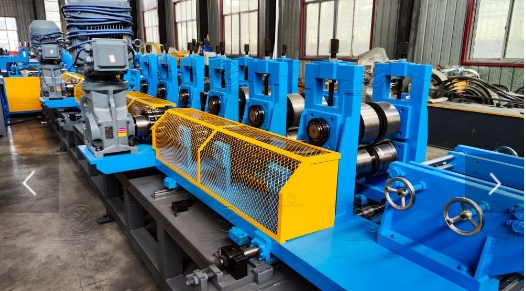
The Door Frame Press Roll Forming Machine Revolutionizing Door Production
In the manufacturing industry, efficiency and precision are essential components for production success. One of the remarkable innovations that have significantly streamlined manufacturing processes is the door frame press roll forming machine. This advanced piece of equipment not only enhances productivity but also guarantees consistent quality in door frame construction.
Understanding Roll Forming
Roll forming is a continuous bending process in which a long strip of metal is passed through consecutive sets of rollers. Each set of rollers progressively shapes the material into the desired cross-section. The door frame press roll forming machine utilizes this technique to produce door frames with exact specifications in terms of size and shape.
Key Features of the Door Frame Press Roll Forming Machine
1. High Precision The door frame press roll forming machine is engineered to produce components with high dimensional accuracy. This is crucial in the construction and assembly of door frames where even minor deviations can lead to installation challenges.
2. Efficiency and Speed Traditional methods of door frame production can be time-consuming and labor-intensive. In contrast, the roll forming process allows for rapid production rates, significantly reducing lead times. Machines can operate at high speeds, allowing manufacturers to meet tight deadlines while keeping production costs down.
3. Versatility These machines are designed to accommodate a variety of materials, including steel, aluminum, and other metals. This versatility makes them suitable for different types of door frames, whether it's for residential projects or industrial applications.
4. Cost-Effective Production By automating the forming process, manufacturers can significantly reduce labor costs and waste material. The efficiency of the roll forming process means that less energy is consumed per unit produced, leading to a lower overall cost of production.

Applications of Door Frame Press Roll Forming Machines
The door frame press roll forming machine is pivotal in a multitude of applications. It is primarily used in the production of door frames for various settings, including residential homes, commercial buildings, and industrial facilities. The structural integrity and aesthetic properties of doors rely heavily on the quality of the frames; therefore, utilizing a press roll forming machine ensures that these components are both durable and visually appealing.
Additionally, these machines are also used in creating frames that accommodate different door types, including hollow metal doors, wood doors, and fiberglass variations. The ability to customize frame dimensions and shapes can enhance the versatility of door manufacturing, allowing for more creative architectural designs.
Adopting Technology in Manufacturing
The rise of Industry 4.0 has encouraged manufacturers to integrate smart technology into production lines. Modern door frame press roll forming machines often come equipped with advanced features such as programmable logic controllers (PLCs) and digital interfaces. These enhancements facilitate real-time monitoring and adjustments, ensuring that machines consistently operate at optimal efficiency.
Moreover, data analytics can be employed to track production metrics and maintenance schedules, reducing downtime and enhancing operational performance. Such technological integration allows manufacturers to adapt to changing market demands swiftly.
Conclusion
The door frame press roll forming machine represents a significant leap forward in the manufacturing of door frames. By combining speed, efficiency, and versatility, this technology has transformed production processes and enabled manufacturers to deliver high-quality products at competitive prices. As the construction industry continues to evolve, investing in innovative machinery like the door frame press roll forming machine will be critical for staying ahead in the market. Emphasizing quality and efficiency not only meets customer demands but also sets the stage for sustainable growth in the manufacturing sector.